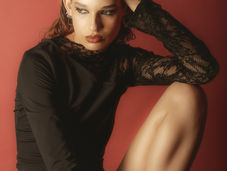Fear, fashion and design in the Cold War: A Talk with Professor Jane Pavitt – 17.11.19
- Stella White
- Nov 11, 2019
- 3 min read
On a wet, chilly night in Kew Gardens, listeners eagerly attended Kingston University professor Jane Pavitt’s talk on fashion and design in the Cold War, as part of the National Archives Cold War season. Pavitt curated an exhibition at the Victoria and Albert Museum in 2008 called 'Cold War Modern', described as an “exploration of design during the Cold War” examining how the body and the environment were shaped by conflict.
Pavitt showed us an image of a Russian fashion model wearing a futuristic catsuit, posing in front the Vostok space capsule in 1968. She began her talk by explaining that the Cold War involved extensive “trade and cultural exchanges” between the Soviet Union and the United States. “You’d be surprised to the extent that the Soviet Union and the United States were exchanging these exhibitions, and their allies, including Britain, were receiving or contributing to this kind of international exchange of Cold War products and images,” she noted.
In 1956, Pavitt explained, the Ideal Home Exhibition in Earls Court featured an “all-plastic home of the future” designed by architects Alison and Peter Smithson. The exhibition imagined what life would be like in 1981. Actors inside the home would perform daily rituals as the public peered in through holes in the wall. “They [the actors] could be in a space capsule, they could be in a space habitat, we don’t know,” she said. “The surroundings might be futuristic, but they’re playing out the conventions of family life in the 1950s.”
Not only is the domesticity representative of the 1950s, Pavitt said, but the artificiality is also indicative of the era in which it was constructed. “There’s no windows, there’s no natural light. The air is filtered, the door's lock sealed. Even if there is an atmosphere outside of the house which could sustain life, it’s not getting inside. Even the food is irradiated. So this isn’t just a home, it’s a nuclear bunker… It’s impossible to not see the parallels, I think, between a home of the future and a place of protection or security.”

Book cover for Fear and Fashion In The Cold War by Jane Pavitt
The Cold War, Pavitt then argued, shaped the design of cities, with propaganda entering everyday life through products and clothing, and even changing the understanding of the human mind. During the first World’s Fair staged in Europe since the Second World War in 1958, she said, nations showcased products and design in pavilions with an emphasis on peace through technology. The Atomium, at the centre of the fair in Brussels, was being “reclaimed as a symbol of peace rather than of warfare”. The American and Soviet pavilions were next to each other, allowing visitors to compare them. The Soviet pavilion focused on “feats of engineering and hard science”, while the American pavilion showcased modern products and a “dramatic catwalk”.
“The success of the exhibition led in some way to a diplomatic exchange between Moscow and New York,” Pavitt said. In a “moment of detente”, travelling exhibitions were sent both ways to showcase life in America and the Soviet Union. Speaking about the body itself, Pavitt argued that bodies and fashion played significant roles in the competition between nations. “In a sense, in the context of the Cold War, the body itself becomes weaponised,” she said. “The wartime image of the blonde bombshell, the bombshell woman, had gone atomic.”
This is encapsulated, she argued, by plastics. Synthetic materials came to the market for the first time in conjunction with technological developments. These new materials climbed the “marketing mountain” in the 1950s and made their way into daily life. Fashion on the catwalk often featured shiny, stretchy materials, and “plenty of silver”. These looks “persisted through film and television” as well as entering the market of the high street.
“What’s interesting about this look… [is] the suggestion that the body is operating in an artificial and perhaps challenging environment, and somehow is more physically vulnerable,” Pavitt said, drawing attention to the masks and helmets that fashion models often sported, at the intersection between sexy and disturbing.
The talk concluded with Pavitt explaining that the design during this period was often an emotional reaction to what was happening in the world, with artists creating “deeply personal” responses.
Edited by Liza Mikhaleva, Fashion Editor
























Comments